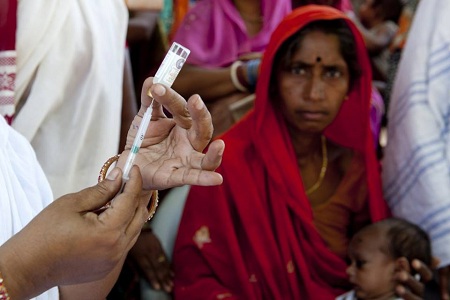How to Be an International Dealmaker: Market nudges are building global vaccine markets
Vaccines are among the most effective and high return-on-investment health interventions in global development. However, while the work of innovative health actors such as the GAVI Alliance and its donors has massively expanded access to basic lifesaving vaccines over the past decade, many potential vaccines are never developed, distributed or tailored to work effectively in the Global South, causing millions of children and adults to suffer from ailments that could have been prevented.
For-profit pharmaceutical companies in both developed and developing countries should be the best placed actors to remedy this situation, given their extensive experience with vaccine research and development (R&D) and production. But pharmaceutical companies often do not enter these markets because developing and expanding vaccine production lines is both extremely expensive (with costs in the hundreds of millions of dollars over several years, including high up-front costs) and risky (given potential adverse outcomes such as failed R&D, lack of funds in the Global South for purchases, or competitor entry). Companies selling other products in developing markets often employ a basic low-cost, high-volume business model, but this method is less feasible in the case of vaccines because success is usually dependent on reaching scale in the tens of millions of doses.
What can be done to build global vaccine markets?
Measures to reduce the costs and risk of developing global vaccines can take a number of forms; all of these methods allow third-party donors such as developed country governments, foundations, nonprofits or consolidated groups of private donors to lubricate global vaccine markets and accelerate vaccine production for the Global South.
The most basic of these methods is for donors to directly subsidize the purchase of vaccines by health nonprofits or governments in the Global South. Subsidies can be complex, however, as it is still unclear how to most effectively balance paying pharmaceutical companies prices that are high enough to motivate further development, while also prioritizing reasonable costs and good value-for-money for the purchasers of these vaccines.

(Photo, left, courtesy of GAVI Alliance.)
Measures that reduce risk for pharmaceutical companies offer a more promising solution; they often achieve the same results as subsidy models, at a much lower cost for global donors. One common example of risk reduction is for donors to provide some form of insurance to a pharmaceutical company – in case its R&D efforts do not pan out – in exchange for better pricing when the product is released. Effectively, this method allows donor programs to use their large size and balance sheets to act as insurance agents for pharmaceutical firms, especially smaller companies. To help pharmaceuticals manage upfront capital investments, global donors can increase the transparency of market sizes by providing pharmaceutical companies with improved market intelligence (such as GAVI’s Strategic Demand Forecasts) or can help reduce unpredictability in funding flows (with programs such as the Pledge Guarantee for Health).
Donors can also leverage volume guarantees to lower vaccine prices and jump-start markets. Volume guarantees commit nonprofits or donors to purchase a predetermined, minimum number of vaccine units from a particular pharmaceutical company, guaranteeing that supplier a certain market size.
The GAVI Alliance has used volume guarantees to achieve a record low price for human papillomavirus (HPV) vaccines with Merck and GlaxoSmithKline, lowering it from the U.S. price of about $130 per dose to under $5 per dose in developing countries. The Jadelle Access Program has reduced the price for a best-in-class contraceptive implant from $16.50 to $8.50 by providing a purchase guarantee of 27 million doses over five years. Additionally, GAVI’s Advanced Market Commitment (AMC) for Pneumococcal Vaccines provided a guarantee to would-be manufacturers of pneumococcal vaccines that if they developed and produced the product, the demand would be there. In the end, the AMC secured a price per vaccine of $3.50 instead of the earlier price of more than $100 per dose.
How can donors deploy these innovative methods of market creation?
Dalberg’s evaluation of the Pneumococcal AMC revealed several specific lessons on how to negotiate and partner with international vaccine manufacturers to reduce their risks while setting affordable prices for vaccines in the developing world. Providing commitments such as insurance or volume guarantees to pharmaceutical companies can be difficult for donors, however. Such commitments require donors to put substantial funds on their balance sheet years before they are actually spent, which can be challenging for governments or organizations with budgets allocated on an annual basis. Moreover, guarantees need to be well-tailored in timeline, scope, price and structure. Yet, when done right, insurance, volume guarantees and market interventions are extraordinarily powerful mechanisms to drive markets for vaccines.
Often, the dialogue on how to increase innovation and reduce costs of expensive pharmaceuticals for low-income countries focuses on how much donors should directly subsidize product development. In the past, donors focused on the price and negotiation process rather than considering a broader suite of risk mitigation strategies that can encourage pharmaceutical company interest. A new approach – reducing risk for manufacturers by using donors’ balance sheets and the promise of future purchases – may more effectively entice pharmaceutical companies to enter and compete in the market.
Recent risk reduction measures such as the GAVI Alliance’s deal for HPV vaccines, the Jadelle Access Program and the GAVI Alliance’s Advanced Market Commitment (AMC) for Pneumococcal Vaccines show the promise of such approaches to reduce prices and increase access while engaging manufacturers and stimulating innovation in the vaccine market.
Angela Rastegar Campbell is the founder of Agora Fund and Ya’ir Aizenman is a project leader at Dalberg Global Development Advisors, where he focuses on improving the design and delivery and global health interventions.
- Categories
- Health Care
- Tags
- vaccines
